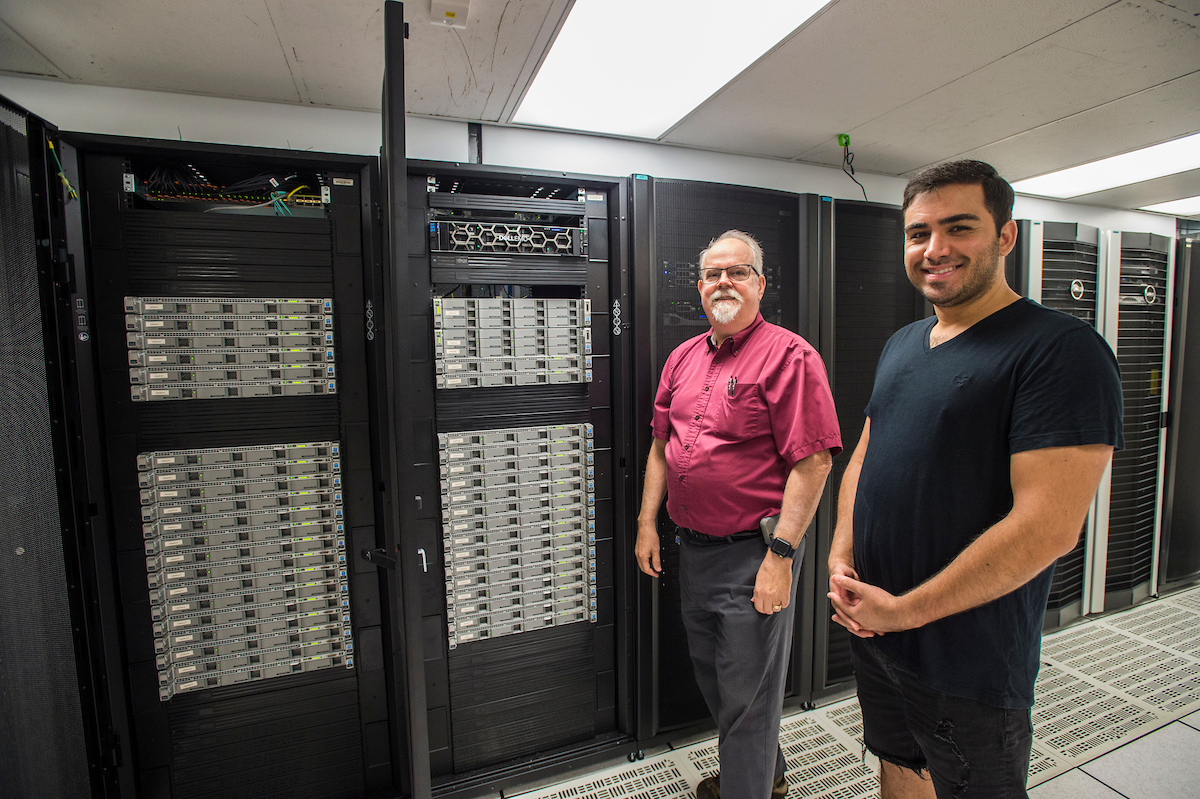
“Big Dawg” – Chet Langin and Majid Memari, graduate assistant, with the “Big Dawg” supercomputer at Southern Illinois University Carbondale. (Photo by Steve Buhman)
August 03, 2018
Using supercomputers to monitor the global food supply
CARBONDALE, Ill. — With 250-350 gigabytes of storage, the average computer is fairly capable of solving basic problems. But when those numbers jump up to the 48,000 gigabytes of storage found on the supercomputer at Southern Illinois University Carbondale, a researcher can quickly run complex calculations on topics such as genetic sequencing and atmospheric science. Or create a geospatial model to support the global food economy.
For the last two years, Chet Langin, OIT research coordinator at SIU, has worked with researchers to use the high performance computing cluster, fondly known as the “BigDawg,” to conduct a variety of projects.
With a theoretical 34.7 teraflops of processing power and 48 terabytes of usable storage, the “Big Dawg” is capable of completing tasks in just hours, rather than several days.
Working with a national research team to plan for the future
In recognition of Langin’s work, he was recently accepted as one of five to receive the 2018-19 Extreme Science and Engineering Discovery Environment (XSEDE) Campus Champions Fellowship.
Charged with the job of assisting researchers from Purdue University, Langin will spend 12 months working with an agriculture model that is set to untangle the food and environmental issues found in the world’s farm-food system. The team of researchers has already created an open-source tool, and is now collecting data for the next step of the project.
“They [Purdue researchers] have divided up the globe into 36,000 cells. So the entire globe, or at least the entire land surface area of the globe, has been divided into a cell,” Langin said. “For each cell, then they collect information such as climate impacts, water scarcity, biodiversity, terrestrial carbon stocks and food security for that area.”
The researchers then assign values to each cell. The next step is to set up a model where they project into the future to perceive how the cells interact with one another, and determine how much food will be available in each cell, Langin explained.
Once the model is set up, the researchers can change the variables to plan for potential problems or food shortages.
Making information accessible to researchers
As Langin works on this project, his goal is to transfer the information he learns to the work done at SIU. He will help perform calculations with this data by using one of the clusters found at the other 20 universities that have similar high performance computing clusters.
“But then I will also learn how to do that on our ‘Big Dawg’ cluster,” Langin said. “I will be able to transfer that knowledge here.”
XSEDE, funded by the National Science Foundation, is a program that scientists use to interactively share computing resources, data and expertise. People from across the globe access the resources and services of this program, and work together to improve the planet.
While no one organization has all of the solutions, the world-wide collaboration provides better hope for solving complex issues for years to come.
“Big Dawg” available for local research projects
This is the second time for Langin to receive the fellowship appointment, and he continues to use his experience to provide assistance to a variety of research projects. While usually used in fields such as engineering and physics, the “Big Dawg” is available for any university researcher or student who is working with large amounts of data.
Langin hopes to work interdepartmentally at SIU to give researchers the help they need to make new discoveries and solve problems. To find out more information about using the “Big Dawg,” contact Chet Langin at 618/536-2438.
